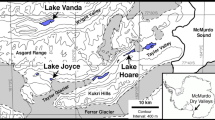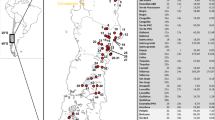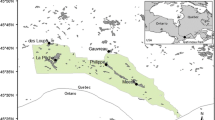Abstract
Despite the dominance of cyanobacteria in polar freshwater aquatic ecosystems, little is known about their past biodiversity and response to climate and environmental changes. We explored the use of light microscopy of microfossils, high performance liquid chromatography of the fossil pigment composition and denaturing gradient gel electrophoresis of fossil 16S rRNA genes to study past and present-day differences in cyanobacterial community structure in response to climate changes in two adjacent maritime Antarctic lakes with contrasting depths (4 and 26 m) and light climates. Light microscopy was of limited use because of degradation of cell structures. Fossil cyanobacterial pigment concentrations were below the detection limits of our method in several sediment samples in the deep lake, but abundant and diverse in the sediment core from the shallow pond, probably as a consequence of increased light availability and/or a more diverse and abundant benthic cyanobacterial flora. Total carotenoid and chlorophyll concentrations were highest in both lakes between ca. 2,950 and 1,800 cal yr BP, which coincides with the late Holocene climate optimum recognised elsewhere in maritime Antarctica. Cyanobacterial molecular diversity was higher in the top few centimeters of the sediments in both lakes. In deeper sediments, the taxonomic turnover of cyanobacteria appeared to be relatively small in response to past climate anomalies in both lakes, underscoring the broad tolerance of cyanobacteria to environmental variability. This, however, may in part be explained by the low taxonomic resolution obtained with the relatively conserved 16S rRNA gene and/or the preferential preservation of particular taxa. Our results highlight the potential of fossil DNA in lake sediments to study colonization and succession dynamics of lacustrine cyanobacteria and warrant further investigation of the factors that affect preservation of cyanobacterial DNA.






Similar content being viewed by others
References
Anderson-Carpenter L, McLachlan J, Jackson S, Kuch M, Lumibao C, Poinar H (2011) Ancient DNA from lake sediments: bridging the gap between paleoecology and genetics. BMC Evol Biol 11:30. doi:10.1186/1471-2148-11-30
Bennett KD, Willis KJ (2001) Terrestrial, algal, and siliceous indicators. In: Smol JP, Birks JB, Last WM (eds) Tracking environmental change using lake sediments. Kluwer Academic Publishers, Dordrecht, pp 5–33
Bentley M, Hodgson D, Smith J, Cofaigh C, Domack E, Larter R (2009) Mechanisms of Holocene palaeoenvironmental change in the Antarctic Peninsula region. Holocene 19:51–69
Blaauw M (2010) Methods and code for ‘classical’ age-modelling of radiocarbon sequences. Quat Geochronol 5:512–518
Boere AC, Sinninghe Damsté JS, Rijpstra WI, Volkman JK, Coolen MJL (2011) Source-specific variability in post-depositional DNA preservation with potential implication for DNA based paleoecological records. Org Geochem 42:1216–1225
Cho JC, Tiedje JM (2000) Biogeography and degree of endemicity of fluorescent Pseudomonas strains in soil. Appl Environ Microbiol 66:5448–5456
Cole JR, Wang Q, Cardenas E, Fish J, Chai B, Farris RJ, Kulam-Syed-Mohideen AS, McGarrell DM, Marsh T, Garrity GM, Tiedje JM (2009) The Ribosomal Database Project: improved alignments and new tools for rRNA analysis. Nucleic Acids Res 37:D141–D145
Coolen MJL, Muyzer G, Rijpstra WIC, Schouten S, Volkman JK, Sinninghe Damsté JS (2004) Combined DNA and lipid analyses of sediments reveal changes in Holocene haptophyte and diatom populations in an Antarctic lake. Earth Planet Sci Lett 223:225–239
Coolen MJL, Talbot HM, Abbas BA, Ward C, Schouten S, Volkman JK, Sinninghe Damsté JS (2008) Sources for sedimentary bacteriohopanepolyols as revealed by 16S rDNA stratigraphy. Environ Microbiol 10:1783–1803
Fernandez-Carazo R, Hodgson DA, Convey P, Wilmotte A (2011) Low cyanobacterial diversity in biotopes of the Transantarctic Mountains and Shackleton Range (80–82 degrees S), Antarctica. FEMS Microbiol Ecol 77:503–517
Golubic S, Radoicic R, Seong-Joo L (2006) Decastronema kotori gen. nov., comb. nov: a mat-forming cyanobacterium on Cretaceous carbonate platforms and its modern counterparts. Carnets de Géologie-Notebooks on Geology, Brest, Article 2006/02 (CG2006_A02), 17 p
Hebsgaard MB, Phillips MJ, Willerslev E (2005) Geologically ancient DNA: fact or artefact? Trends Microbiol 13:212–220
Hodgson DA, Smol JP (2008) High latitude palaeolimnology. In: Vincent WF, Laybourn-Parry J (eds) Polar lakes and rivers: limnology of Arctic and Antarctic aquatic ecosystems. Oxford University Press, Oxford, pp 43–64
Hodgson DA, Vyverman W, Verleyen E, Sabbe K, Leavitt PR, Taton A, Squier AH, Keely BJ (2004) Environmental factors influencing the pigment composition of in situ benthic microbial communities in east Antarctic lakes. Aquat Microb Ecol 37:247–263
Hodgson DA, Vyverman W, Verleyen E, Leavitt PR, Sabbe K, Squier AH, Keely BJ (2005) Late Pleistocene record of elevated UV radiation in an Antarctic lake. Earth Planet Sci Lett 236:765–772
Hodgson DA, Roberts D, McMinn A, Verleyen E, Terry B, Corbett C, Vyverman W (2006) Recent rapid salinity rise in three East Antarctic lakes. J Paleolimnol 36:385–406
Hua Q, Barbetti M (2004) Review of tropospheric bomb C-14 data for carbon cycle modeling and age calibration purposes. Radiocarbon 46:1273–1298
Jeffrey SW, Vesk M, Mantoura RFC (1997) Phytoplankton pigments: windows into the pastures of the sea. Nat Resour 33:14–29
Jukes TH, Cantor CR (1969) Evolution of protein molecules. In: Munro HN (ed) Mammalian protein metabolism. Academic Press, New York, 3:21–132
Jungblut AD, Lovejoy C, Vincent WF (2009) Global distribution of cyanobacterial ecotypes in the cold biosphere. ISME J 4:191–202
Kodner RB, Summons RE, Knoll AH (2009) Phylogenetic investigation of the aliphatic, nonhydrolyzable biopolymer algaenan, with a focus on green algae. Org Geochem 40:854–862
Kwok S, Kellogg DE, McKinney N, Spasic D, Goda L, Levenson C, Sninsky J (1990) Effects of primer-template mismatches on the polymerase chain reaction: human immunodeficiency virus type 1 model studies. Nucl Acids Res 18:999–1005
Laybourn-Parry J, Pearce DA (2007) The biodiversity and ecology of Antarctic lakes: models for evolution. Philos Trans R Soc Lond B Biol Sci 362:2273–2289
Leavitt PR, Hodgson DA (2001) Sedimentary pigments. In: Smol JP, Birks JHB, Last WM (eds) Developments in paleoenvironmental research. Tracking environmental changes using lake sediments. Kluwer Academic Publishers, Dordrecht, pp 295–325
Mergeay J, Vanoverbeke J, Verschuren D, De Meester L (2007) Extinction, recolonisation and dispersal through time in a planktonic crustacean. Ecology 88:3032–3043
Muyzer G (1999) DGGE/TGGE: a method for identifying genes from natural ecosystems. Curr Opin Microbiol 2:317–422
Nübel U, Garcia-Pichel F, Muyzer G (1997) PCR primers to amplify 16S rRNA genes from cyanobacteria. Appl Environ Microbiol 63:3327–3332
Panieri G, Lugli S, Manzi V, Roveri M, Schreiber BC, Palinska KA (2010) Ribosomal RNA gene fragments from fossilized cyanobacteria identified in primary gypsum from the late Miocene, Italy. Geobiology 8:101–111
Parker BR, Vinebrooke RD, Schindler DW (2008) Recent climate extremes alter alpine lake ecosystems. Proc Natl Acad Sci USA 105:12927–12931
Powell LM, Bowman JP, Skerratt JH, Franzmann PD, Burton HR (2005) Ecology of a novel Synechococcus clade occurring in dense populations in saline Antarctic lakes. Mar Ecol Prog Ser 291:65–80
Quayle WC, Peck LS, Peat H, Ellis-Evans JC, Harrigan PR (2002) Extreme responses to climate change in Antarctic lakes. Science 295:645
Räsänen J, Kauppila T, Vuorio K (2006) Sediment and phytoplankton records of the cyanobacterial genus Anabaena in boreal Lake Pyhajarvi. Hydrobiologia 568:455–465
Rautio M, Bayly I, Gibson J, Nyman M (2008) Zooplankton and zoobenthos in high-latitude water bodies. In: Vincent WF, Laybourn-Parry J (eds) Polar lakes and rivers. Oxford University Press, Oxford, pp 231–247
Reimer PJ, Baillie MGL, Bard E, Bayliss A, Beck JW, Blackwell PG, Ramsey CB, Buck CE, Burr GS, Edwards RL, Friedrich M, Grootes PM, Guilderson TP, Hajdas I, Heaton TJ, Hogg AG, Hughen KA, Kaiser KF, Kromer B, McCormac FG, Manning SW, Reimer RW, Richards DA, Southon JR, Talamo S, Turney CSM, van der Plicht J, Weyhenmeye CE (2009) Intcal09 and Marine09 radiocarbon age calibration curves, 0–50,000 years cal Bp. Radiocarbon 51:1111–1150
Roberts SJ, Hodgson DA, Sterken M, Whitehouse PL, Verleyen E, Vyverman W, Sabbe K, Balbo A, Bentley MJ, Moreton SG (2011) Geological constraints on glacio-isostatic adjustment models of relative sea-level change during deglaciation of Prince Gustav Channel, Antarctic Peninsula. Quat Sci Rev 30:3603–3617
Sabbe K, Verleyen E, Hodgson DA, Vanhoutte K, Vyverman W (2003) Benthic diatom flora of freshwater and saline lakes in the Larsemann Hills and Rauer Islands, East Antarctica. Antarct Sci 15:227–248
Saitou N, Nei M (1987) The neighbor-joining method—a new method for reconstructing phylogenetic trees. Mol Biol Evol 4:406–425
Savichtcheva O, Debroas D, Kurmayer R, Villar C, Jenny JP, Arnaud F, Perga ME, Domaizon I (2011) Quantitative PCR enumeration of total/toxic Planktothrix rubescens and total cyanobacteria in preserved DNA isolated from lake sediments. Appl Environ Microbiol 77:8744–8753
Schloss PD, Handelsman J (2005) Introducing DOTUR, a computer program for defining operational taxonomic units and estimating species richness. Appl Environ Microbiol 71:1501–1506
Smol JP, Douglas MSV (2007) From controversy to consensus: making the case for recent climate using lake sediments. Front Ecol Environ 5:466–474
Smol JP, Wolfe AP, Birks HJB, Douglas MSV, Jones VJ, Korhola A, Pienitz R, Ruhland K, Sorvari S, Antoniades D, Brooks SJ, Fallu MA, Hughes M, Keatley BE, Laing TE, Michelutti N, Nazarova L, Nyman M, Paterson AM, Perren B, Quinlan R, Rautio M, Saulnier-Talbot E, Siitonen S, Solovieva N, Weckstrom J (2005) Climate-driven regime shifts in the biological communities of arctic lakes. Proc Natl Acad Sci USA 102:4397–4402
Souffreau C, Vanormelingen P, Van de Vijver B, Isheva T, Verleyen E, Sabbe K, Vyverman W (2013) Molecular evidence for distinct Antarctic lineages in the cosmopolitan terrestrial diatoms Pinnularia borealis and Hantzschia amphioxys. Protist 164:101–115
Sterken M, Roberts SJ, Hodgson DA, Vyverman W, Balbo A, Sabbe K, Moreton S, Verleyen E (2012) Deglaciation history and Holocene climate dynamics in Beak Island, northeastern Antarctic Peninsula. Quat Sci Rev. doi:10.1016/j.quascirev.2011.10.017
Taton A, Grubisic S, Brambilla E, De Wit R, Wilmotte A (2003) Cyanobacterial diversity in natural and artificial microbial mats of Lake Fryxell (McMurdo dry valleys, Antarctica): a morphological and molecular approach. Appl Environ Microbiol 69:5157–5169
Taton A, Grubisic S, Balthasart P, Hodgson DA, Laybourn-Parry J, Wilmotte A (2006a) Biogeographical distribution and ecological ranges of benthic cyanobacteria in East Antarctic lakes. FEMS Microbiol Ecol 57:272–289
Taton A, Grubisic S, Ertz D, Hodgson DA, Piccardi R, Biondi N, Tredici MR, Mainini M, Losi D, Marinelli F, Wilmotte A (2006b) Polyphasic study of Antarctic cyanobacterial strains. J Phycol 42:1257–1270
Tomescu AMF, Rothwell GW, Honegger R (2009) A new genus and species of filamentous microfossil of cyanobacterial affinity from Early Silurian fluvial environments (lower Massanutten Sandstone, Virginia, USA). Bot J Linn Soc 160:284–289
Van de Peer Y, De Wachter R (1997) Construction of evolutionary distance trees with TREECON for Windows: accounting for variation in nucleotide substitution rate among sites. Comput Appl Biosci 13:227–230
Verleyen E, Hodgson DA, Leavitt PR, Sabbe K, Vyverman W (2004) Quantifying habitat-specific diatom production: a critical assessment using morphological and biochemical markers in Antarctic marine and lake sediments. Limnol Oceanogr 49:1528–1539
Verleyen E, Hodgson DA, Sabbe K, Vyverman W (2005) Late Holocene changes in ultraviolet radiation penetration recorded in an East Antarctic lake. J Paleolimnol 34:191–202
Verleyen E, Sabbe K, Hodgson DA, Grubisic S, Taton A, Cousin S, Wilmotte A, De Wever A, Van der Gucht K, Vyverman W (2010) Structuring effects of climate-related environmental factors on Antarctic microbial mat communities. Aquat Microb Ecol 59:11–24
Verleyen E, Hodgson DA, Gibson J, Imura S, Kaup E, Hoshino T, Kanda H, Kudoh S, De Wever A, Hoshino T, McMinn A, Obbels D, Roberts D, Roberts SJ, Sabbe K, Souffreau C, Tavernier I, Van Nieuwenhuyze W, Van Ranst E, Vindevogel N, Vyverman W (2012) Chemical limnology in coastal East Antarctic lakes: monitoring future climate change in centres of endemism and biodiversity. Antarct Sci 24:23–33
Vincent WF (2000) Evolutionary origins of Antarctic microbiota: invasion, selection and endemism. Cambridge Univ Press, Cambridge, pp 374–385
Vincent WF, Bowman JP, Rankin LM, McMeekin TA (2000) Phylogenetic diversity of picocyanobacteria in Arctic and Antarctic ecosystems. In: Bell CR, Brylinsky M, Johnson-Green P (eds) Microbial biosystems: new frontiers proceedings of the 8th international symposium on microbial ecology. Atlantic Canada Society for Microbial Ecology, Halifax (Canada), pp 317–322
Wagner B, Seppelt R (2006) Deep-water occurrence of the moss Bryum pseudotriquetrum in Radok Lake, Amery Oasis, East Antarctica. Polar Biol 29:791–795
Wharton RA, Parker BC, Simmons GM (1983) Distribution, species composition and morphology of algal mats in Antarctic dry valley lakes. Phycologia 22:355–365
Whitton BA, Potts M (2000) Introduction to the cyanobacteria. In: Whitton BA, Potts M (eds) The ecology of cyanobacteria. Their diversity in time and space. Kluwer Academic Publishers, Dordrecht, pp 1–11
Willerslev E, Cooper A (2005) Ancient DNA. Proc R Soc Lond B Biol Sci 272:3–16
Wilmotte A, Demonceau C, Goffart A, Hecq J-H, Demoulin V, Crossley AC (2002) Molecular and pigment studies of the picophytoplankton in a region of the Southern Ocean (47 to 54°S, 141 to 144°E) in March 1998. Deep-Sea Res II 49:3351–3363
Wood SA, Jentzsch K, Rueckert A, Hamilton DP, Cary SC (2008) Hindcasting cyanobacterial communities in Lake Okaro with germination experiments and genetic analyses. FEMS Microbiol Ecol 67:252–260
Wright SW, Jeffrey SW, Mantoura RFC, Llewellyn CA, Bjornland T, Repeta D, Welschmeyer N (1991) Improved HPLC method for the analysis of chlorophylls and carotenoids from marine-phytoplankton. Mar Ecol Prog Ser 77:183–196
Acknowledgments
This study was supported by the BelSPO project HOLANT (SD/CA/01A) and the British Antarctic Survey. Annick Wilmotte is Research Associate of the FRS-FNRS (National Funds for Scientific Research of Belgium). Elie Verleyen was funded by the Research Foundation—Flanders and Ghent University. Thanks are due to Ines Tavernier for providing the extracted fossil DNA, to Renaat Dasseville for help with the fossil pigment analysis, to Mieke Sterken for providing background information, and to Alexandre Lambion and Léo Deremiens for their help in the laboratory. Logistic support was provided by the British Antarctic Survey, HMS Endurance and 815 Naval Air Squadron. Two anonymous reviewers and Prof. Dr. Mark Brenner are thanked for the valuable comments on an earlier version of the manuscript.
Author information
Authors and Affiliations
Corresponding author
Additional information
Rafael Fernandez-Carazo and Elie Verleyen contributed equally to this work.
Electronic supplementary material
Below is the link to the electronic supplementary material.
Rights and permissions
About this article
Cite this article
Fernandez-Carazo, R., Verleyen, E., Hodgson, D.A. et al. Late Holocene changes in cyanobacterial community structure in maritime Antarctic lakes. J Paleolimnol 50, 15–31 (2013). https://doi.org/10.1007/s10933-013-9700-3
Received:
Accepted:
Published:
Issue Date:
DOI: https://doi.org/10.1007/s10933-013-9700-3




